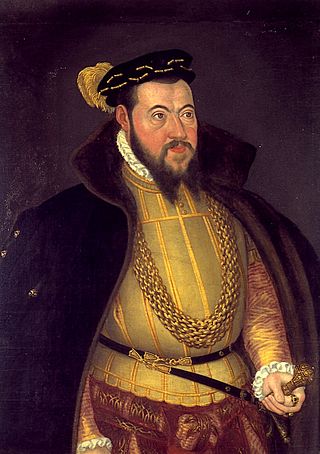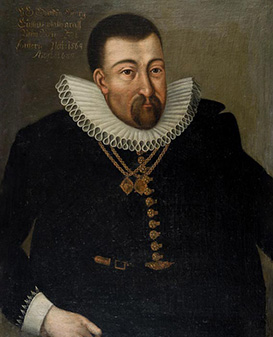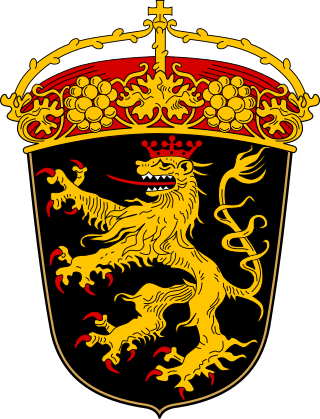
The Duchy of Palatinate-Zweibrücken was a duchy of the Holy Roman Empire with full voting rights to the Reichstag. Its capital was Zweibrücken. The reigning house, a branch of the Wittelsbach dynasty, was also the Royal House of Sweden from 1654 to 1720.

The County Palatine of Veldenz was a principality in the contemporary Land Rhineland-Palatinate with full voting rights to the Reichstag. The county was located partially between Kaiserslautern, Sponheim and Zweibrücken, partially on the Mosel in the Archbishopric of Trier. A municipality of the same name, Veldenz, and a castle, Schloss Veldenz, are located in the district of Bernkastel-Wittlich.

Count Palatine Wolfgang of Zweibrücken was member of the Wittelsbach family of the Counts Palatine and Duke of Zweibrücken from 1532. With the support of his regent, his uncle Rupert, Wolfgang introduced the Reformation to Zweibrücken in 1537.

Princess Anna of Sweden, also known as Anna Maria and Anne Marie, was a Countess Palatine consort of Veldenz by marriage to George John I, Count Palatine of Veldenz. She served as Interim Regent from 1592 to 1598, and supervised the partition of the territories between her sons. She was the daughter of King Gustav I of Sweden and Queen Margaret.

Lohnweiler is an Ortsgemeinde – a municipality belonging to a Verbandsgemeinde, a kind of collective municipality – in the Kusel district in Rhineland-Palatinate, Germany. It belongs to the Verbandsgemeinde Lauterecken-Wolfstein.

Theisbergstegen is an Ortsgemeinde – a municipality belonging to a Verbandsgemeinde, a kind of collective municipality – in the Kusel district in Rhineland-Palatinate, Germany. It belongs to the Verbandsgemeinde of Kusel-Altenglan, whose seat is in Kusel.

La Petite-Pierre is a commune in the Bas-Rhin department in Grand Est in north-eastern France. It lies in the historical and cultural region of Alsace. Petit-Pierre literally means little rock.

Otto Henry of Sulzbach was the Count Palatine of Sulzbach from 1569 until 1604.
Louis Philip was the co-Duke of Veldenz from 1592 until 1598 and the Duke of Guttenberg from 1598 until 1601.
George John II was the co-Duke of Veldenz from 1592 until 1598 and the Duke of Guttenberg from 1598 until 1611, and the Duke of Lützelstein-Guttenberg from 1611 until 1654.

George Gustavus was the Count of Veldenz from 1592 until 1634.

John Augustus was the co-Duke of Veldenz from 1592 until 1598 and the Duke of Lützelstein from 1598 until 1611.

Palatinate-Lützelstein was an ephemeral state of the Holy Roman Empire based around La Petite-Pierre, located in the Vosges Mountains, in the present-day Bas-Rhin and Moselle départements of the Grand Est region in northeastern France.
Palatinate-Lützelstein-Guttenberg was a state of the Holy Roman Empire based around La Petite-Pierre in the far northeast of France.

George John I was the Count of Veldenz from 1544 until 1592.

Leopold Louis was the Count of Veldenz from 1634 until 1694.
George John may refer to:

Countess Agatha Christine of Hanau-Lichtenberg was a daughter of Count Philip Wolfgang (1595-1641) and his wife, Countess Johanna of Oettingen (1602-1639).

The Palatine Lion, less commonly the Palatinate Lion, is an heraldic charge. It was originally part of the family coat of arms of the House of Wittelsbach and is found today on many coats of arms of municipalities, counties and regions in South Germany and the Austrian Innviertel.

The Veldenz Schloss of Lauterecken stands in the little Palatine town of Lauterecken and is a cultural monument. It was once the residence of the counts of Palatinate-Veldenz, who lived for four generations that lasted for 151. The schloss is at Veldenzplatz 1. Since 2017 it has been converted and renovated internally in order to become a new 'jewel' for the town of Lauterecken.
This page is based on this
Wikipedia article Text is available under the
CC BY-SA 4.0 license; additional terms may apply.
Images, videos and audio are available under their respective licenses.















